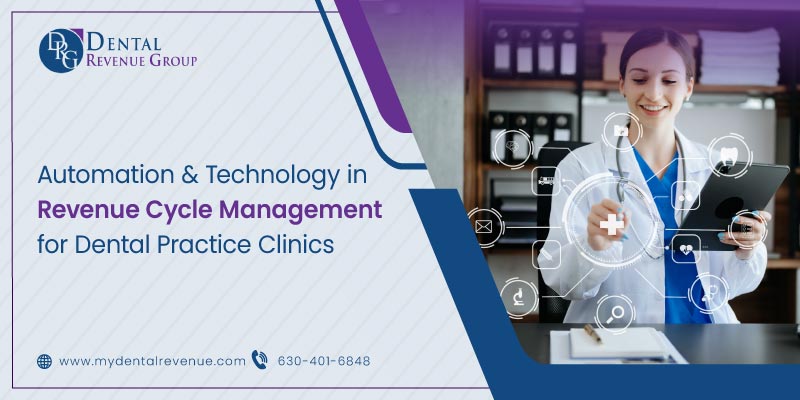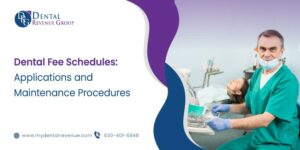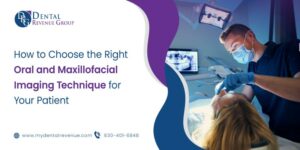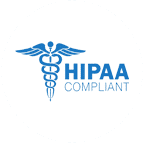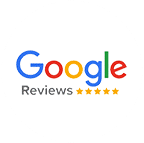In the ever-evolving landscape, businesses increasingly realize the limitations of traditional revenue cycle management (RCM) practices. Enter an innovative technology that reshapes how organizations manage their revenue cycles. This cutting-edge solution offers scalability, enhanced efficiency, and cost savings, enabling businesses to thrive in today’s highly competitive markets. This streamlined approach improves accuracy, reduces errors, accelerates task completion, and leads to increased revenue.
Introduction to Revenue Cycle Management
Revenue cycle management (RCM) is the financial process used to manage the clinical, administrative, and billing activities associated with patient care. Effective RCM ensures the dental practice is reimbursed for services rendered while maintaining optimal financial performance.
RCM is a critical component of managing a successful dental practice. It systematically tracks all revenue generation activities – from patient appointment scheduling to insurance claim resolution and payment posting. Smooth RCM workflows minimize claim rejections, reduce accounts receivable days, improve cash flow, and maximize practice profitability.
Current Challenges in Healthcare Revenue Cycle Management
The expansion of dental practices brings new hurdles in effectively managing their revenue cycle. The intricacies of dental billing and insurance procedures, along with changing regulations, present ongoing difficulties. Additionally, the rising demand for dental services intensifies the need for efficient tools to ensure adequate revenue cycle management.
Dental practices often handle time-consuming administrative tasks, including claim submissions, denials management, and patient eligibility verification. This challenge is exacerbated by a growing patient base, necessitating extended work hours to cope with the workload. Increased administrative responsibilities divert staff from delivering quality patient care. Manual handling of tasks introduces errors, leading to delayed payments, rejected claims, and extended collection times. These inefficiencies inconvenience patients and result in revenue losses, posing significant concerns for dental practices.
The front-end staff’s attention to detail can be questionable due to the general nature of their tasks and the potential for human errors. Striking the right balance between encouraging upfront payments from patients without creating undue pressure is a critical but challenging aspect for healthcare organizations.
Additionally, the increasing adoption of telehealth technologies introduces another layer of complexity. Some payers don’t fully recognize the value of virtual consultations and telehealth services, making it challenging for providers to offer such services. This issue mainly affects healthcare revenue cycles as telehealth becomes vital for individuals in remote areas. Technology-driven solutions are increasingly being adopted by dental practices to streamline their operations and enhance scalability in revenue cycle management.
Pain Points in the Conventional Healthcare Revenue Cycle Management Model
- Maintaining consistent profitability in the healthcare revenue cycle.
- Ensuring accurate reimbursement for services provided.
- The need for seamless communication to resolve billing issues.
- Addressing the complexities and consequences of claims rejection and returns.
- Streamlining and simplifying patient information collection.
- Ensuring precise diagnosis and procedure coding for claims accuracy.
- The challenge of accurately verifying patient insurance coverage.
- Ensuring patients fully comprehend their insurance benefits and limitations.
- Managing the expense of maintaining an RCM team.
- Adapting to changing regulations and reimbursement structures.
- Striking the right balance between collecting payments and providing services, especially in cases where upfront payment is required.
How Technology and Automation Enhances Healthcare and Dental Revenue Cycle Management
Investing in effective revenue cycle management software can be a pivotal step toward enhancing the financial performance of a healthcare organization. The benefits of revenue cycle management for dental practices are endless, ranging from claim denials to automatic coding and verification. A crucial factor in selecting the appropriate RCM solution is ensuring it incorporates extensive big data analytics and healthcare-related IT solutions. This can make handling a large amount of information easier through useful dashboards and notifications. Also, some smart revenue cycle management solutions can predict if a claim might get rejected due to missing information and send automated alerts to help administrative staff understand why specific procedures or codes are often denied. Automating the RCM process offers many benefits for dental practices:
Increased efficiency
Manual RCM processes like eligibility checks, claims filing, and payment posting can take much staff time and effort. Automating these tasks allows staff to focus on higher-level responsibilities and patient care instead of administrative work. This streamlines operations and boosts productivity.
Reduced overhead costs
Practices can reduce labor costs by reducing the need for administrative staff focused on RCM tasks. Automation also minimizes the potential for human error that can lead to denied claims and the need for additional follow-up. This results in cost savings from both labor and reduced claim rejections.
Faster payment cycles
Automated systems can submit claims immediately after a patient visit, accelerating the claims submission process. Payments can be automatically posted upon receipt, leading to faster payment collection. This improves cash flow for the practice.
Improved analytics
Automated RCM systems collect and analyze data across the entire revenue cycle. This gives admins comprehensive visibility into performance metrics like denial rates, days in accounts receivable, and collection speed. The insights empower data-driven decision-making to optimize the RCM process further.
Additional Features and Benefits of Automated Revenue Cycle Management Services
| Features | Benefits |
| Tracking of claims through the entire lifecycle | Enhanced visibility and control over claims processing. |
| Automated payment collection | Efficient and timely revenue collection. |
| Claim denials addressed | Swift resolution of claim denials, reducing revenue loss. |
| The steady stream of revenue | Consistent cash flow for medical agencies. |
| Seamless adoption of evolving payment models | Adaptation to changing payment methods and models. |
| Payer-improving payer-provider communications | Improved communication with payers for smoother transactions. |
| Identification of appropriate ICD-10 codes | Accurate coding for precise billing. |
| Overall monitoring for medical billing and coding | Comprehensive oversight of billing and coding processes. |
| Patient appointment scheduling | Streamlined scheduling for improved patient experience. |
| Payer-provider interactions | Enhanced interactions between healthcare providers and payers. |
| Bad debt avoidance | Measures to reduce bad debt and improve financial stability. |
The principal advantage of a digital platform for the healthcare revenue cycle process is the speed and productivity boost. Such software platforms do entirely away with the need for managing physical documentation. This means hospital providers or administrative staff can perform workflows with a few clicks on a screen rather than handle files. Doing so reduces the number of errors, enabling the organization to adhere to HIPAA regulations better, minimize administrative overhead, and serve their patients better.
Top Areas for RCM Automation
Automating key revenue cycle areas can significantly boost dental practices’ efficiency and financial performance. Here are some of the top opportunities for RCM automation:
Eligibility Verification
Verifying patient eligibility and insurance coverage is highly time-consuming when done manually. Automated eligibility checking integrates with practice management software and clearinghouses to verify patients’ benefits instantly. This prevents claim rejections and saves staff hours on phone calls. Automating eligibility verification provides numerous benefits:
- Automated eligibility checks remove human error and provide real-time verification 24/7 through payer databases.
- Eligibility automation enables staff to instantly check a patient’s coverage details during appointment booking. This allows upfront collection of estimated patient payments.
- Automated systems can check patient eligibility at multiple intervals – before appointment, at check-in, and before major procedures. This catches any coverage changes and minimizes surprises.
- Real-time verification reduces time wasted calling payers and frees up staff for more value-added tasks.
- Analytics from automated eligibility systems can uncover trends and problem areas with patient coverage. This allows dental clinics to understand better and manage their revenue cycle.
Claim Submission
Submitting claims electronically through dental billing software and clearinghouses is far faster and more accurate than paper claims. Claims have fewer errors, can be tracked, and are processed quicker. Automation handles sending claims to multiple carriers and following up on unpaid claims. Automating claim submission offers several key benefits for dental practices:
- Automated claim submission eliminates these errors by pulling data directly from the practice management software. Information flows seamlessly from scheduling and clinical charting directly into the claim form. Manual data entry is optional, removing a significant source of mistakes.
- Automation also allows claims to be submitted to payers immediately after procedures are completed. There is no lag time for staff to batch and submit claims. This greatly accelerates the reimbursement timeline. Payments can be received weeks faster compared to manual submission.
- The efficiency gains are enormous as well. Automation eliminates the need for staff to spend hours preparing, reviewing, and transmitting claims. This administrative burden is removed, freeing valuable staff time for more patient-centered tasks.
Payment Posting
Entering insurance payments and patient collections manually opens the door for posting errors. Automated payment posting with remittance data reconciliation posts payments accurately without staff involvement. This saves time, ensures correct posting, and accelerates account reconciliation. Automating payment posting can significantly improve the speed and accuracy of applying patient payments in dental practice. Key benefits of automating payment posting include:
- Electronic payments can be automatically downloaded and posted rather than manually entered by staff, saving significant time. Scanned checks are also posted much faster than typing each one manually.
- With automated options like electronic payment files and check scanning, most payment details are populated without any typing needed, eliminating tedious data entry.
- Payments are posted to patient accounts faster with automation, reducing lag time in updating balances. This enables staff to quickly follow up on delinquent accounts and improves overall cash flow.
- Automating payment posting eliminates bottlenecks in payment processing, reduces errors, frees up staff time, and enables a smoother revenue cycle.
Denial Management
Dealing with claim denials is time-intensive. Automated denial management uses rules-based workflows to auto-adjudicate denials. Staff are notified to act on denials requiring human intervention. This reduces rework and claim write-offs. Analytics identify root causes for preventive action. Denial management is one of the most important areas for automation in revenue cycle management. Manual denial management can be extremely time-consuming and inefficient. Automation helps dental practices quickly identify denial causes, appeal denials, and prevent future denials.
- With automated denial management software, claims can automatically be identified and categorized based on denial reason. The software can match the identified denial reason to the EOB, making it easy for staff to understand why it occurred.
- The denial reason helps determine the appropriate appeals process. Automated systems can auto-appeal denials electronically for quick resolution. Automation prioritizes denials, allowing staff to focus on denials that require personal attention rather than getting bogged down.
- Analytics from automated denial management provide insights to modify processes and prevent future claims denials. The software can track denial reasons and identify trends over time. Staff can then implement targeted solutions to problem areas. For example, adding missing procedure codes or updating insurance eligibility to reduce eligibility-related denials.
- Automated denial management is a key piece of maximizing revenue. It improves staff productivity, reduces A/R days, and increases reimbursement by overcoming some of dental practice’s biggest revenue cycle obstacles. Using automation allows staff to spend less time managing denials and more time on patient care.
Conclusion
The intricacies of revenue cycle management often burden healthcare organizations, diverting their attention from core clinical and administrative duties. Declining cash flows, shrinking margins, and mounting bad debt are the consequences of poor revenue cycle management. The increasing rate of claims rejections further compounds the challenges for healthcare providers. Manual revenue cycle management leaves organizations vulnerable to the magnified impact of even minor human errors, ultimately affecting revenues.
Implementing automation in the revenue cycle process can significantly benefit dental practices. The main takeaways are that automation dramatically improves productivity and efficiency in RCM. It saves dental staff time, minimizes human errors, and speeds up the billing and collections process. This translates into increased practice revenue and profitability. When implemented effectively, digital RCM solutions offer healthcare organizations the goal – maximized profits. The ROI from RCM automation makes it a smart investment for long-term financial health.

